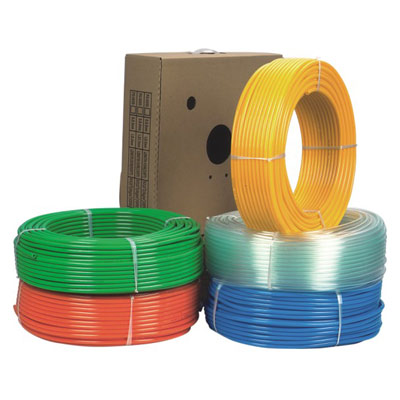PU and TPU are new types of plastics. Because both materials have good processability, weather resistance, and environmental protection, they are widely used in shoes, pipes, films, rollers, cables and wires and other related industries. As a professional hose manufacturer, I will introduce the difference between PU and TPU materials
 Polyurethane thermoplastic elastomer, also known as thermoplastic polyurethane rubber, referred to as TPU, is an (AB) n-type block linear polymer, A is a high molecular weight (1000-6000) polyester or polyether, and B is a polymer containing 2-12 straight For the chain carbon diol, the chemical structure between AB segments is connected by diisocyanate, usually MDI. The general structure is shown in the figure. Thermoplastic polyurethane rubber relies on intermolecular hydrogen bonding or light crosslink between macromolecular chains. As the temperature increases or decreases, these two crosslinked structures are reversible. In the molten state or the solution state, the intermolecular force is weakened, and after cooling or the solvent is volatilized, there is a strong intermolecular force connected together to restore the original solid performance.
Polyurethane thermoplastic elastomer, also known as thermoplastic polyurethane rubber, referred to as TPU, is an (AB) n-type block linear polymer, A is a high molecular weight (1000-6000) polyester or polyether, and B is a polymer containing 2-12 straight For the chain carbon diol, the chemical structure between AB segments is connected by diisocyanate, usually MDI. The general structure is shown in the figure. Thermoplastic polyurethane rubber relies on intermolecular hydrogen bonding or light crosslink between macromolecular chains. As the temperature increases or decreases, these two crosslinked structures are reversible. In the molten state or the solution state, the intermolecular force is weakened, and after cooling or the solvent is volatilized, there is a strong intermolecular force connected together to restore the original solid performance.
Polyurethane thermoplastic elastomers are of two types: polyester and polyether. White irregular spherical or columnar particles have a relative density of 1.10-1.25. Polyether has a lower relative density than polyester. The glass transition temperature of the polyether type is 100.6 to 106.1 ° C, and the glass transition temperature of the polyester type is 108.9 to 122.8 ° C. The brittle temperature of polyether type and polyester type is lower than -62 ℃, and the low temperature resistance of hard ether type is concerned about polyester type.
The outstanding characteristics of polyurethane thermoplastic elastomers are excellent abrasion resistance, excellent ozone resistance, high hardness, high strength, good elasticity, low temperature resistance, good oil resistance, chemical resistance and environmental resistance, and polyether in humid environments. Type esters have much better hydrolytic stability than polyester types.
Polyurethane thermoplastic elastomer is non-toxic and odorless. It can be dissolved in methyl ethyl acetone, cyclohexanone, tetrahydrofuran, dioxane, dimethylformamide and other solvents. Proportionally mixed solvents are colorless and transparent, and have good storage stability.

PU polyurethane is a general term for a polymer compound formed by the reaction of a diisocyanate or a polyisocyanate with a compound having more than two hydroxyl groups, and its main chain contains many repeated NHCOO groups. Commonly used diisocyanates are toluene diisocyanate (TDI), diphenylmethane diisocyanate (MDI), hexamethylene diisocyanate (HDI), isophorone diisocyanate (IPDI), dicyclohexylmethane diisocyanate (HMDI) polymethylene Polyphenylene polyisocyanate (PAPI) xylylene diisocyanate (XDI) and the like. According to the different hydroxyl components, it can be divided into two types: polyester and polyether. Can be used to make plastic products, wear-resistant synthetic rubber products, synthetic fibers, rigid and flexible foam plastic products, adhesives and coatings.
TPU and PU are essentially composed of the same material. But when making these two compounds. They use different formulations. So there are some differences in performance.





